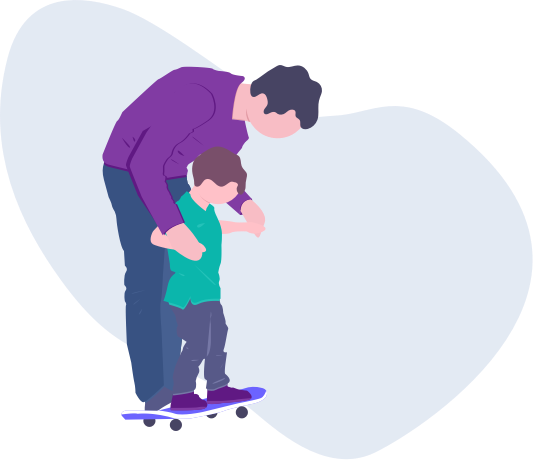

For many children helping them get back to their usual routine and activities is the right thing to do. But it can take some time for life to return to normal.
Routines are helpful in establishing a safe and predictable space. Having these predictable routines is useful, especially after experiencing something which was intense and unpredictable.
Having routines can also create the space to work with them to explore trauma-related emotions.
So, it is important to gradually return to normal, as well as maintaining previous expectations of acceptable behaviour (e.g., manners, bedtime, screen-time).
These routines can include things that your child did before and may find it difficult now. For example, going to school or getting to sleep.
Your child may find it difficult to do things they did before – especially when certain places or activities remind them of their experience.
Explore the tabs below to learn about how to support your child through facing their fears so they can get back to normal, and some tips on building a healthy night-time routine. Once you have finished reading, you can explore activities you can do at the bottom of the page.
It is challenging, but really important, for your child to face their fears. Slowly taking on challenges can help them learn new coping skills and return to normal.
The good news is that, with time and patience, it is completely possible to go back to normal.
It’s normal—and okay—for your child to feel scared at first. Once they start to see what they can achieve and realize that they can be safe things should become easier.
Be prepared for ups and downs - sometimes it may seem like you take a step backwards. Be patient and keep focused on what you have achieved.
Below is a diagram outlining the cycle linking symptoms and avoidance.
Your child may feel afraid to face fears, which can lead to physical sensations (e.g., feeling shaky, increased heartbeat, nightmares), unhelpful thoughts (e.g., "I cannot do this", "I will never be normal again"), and they may fall back onto avoiding doing certain things. This can prevent them from learning that they are capable of facing fears and overcoming unhelpful thoughts.
As a parent, you are in a key position to safely support them and break this cycle.
It is understandable for children to feel scared when facing fears.
However, it is important to encourage them and perhaps talk about how you can make facing the fear more manageable.
For example, by breaking the fear down into smaller steps. You can work out how to reach them using the step-by-step approach described under 'How can we re-build routines and face fears?' below.
If it seems too hard, look for support.
As a parent or carer, you are a great role model and source of support for your child. You can work with your child to gradually build up to a goal (e.g., going back to school, going to a certain place associated with the experience, meeting friends, etc.)
Children can also learn from others’ reactions. So, if you are displaying anxiety around facing fears or feeling emotions, they may tune into this and take on these patterns themselves. This can keep both yours and your child’s fears and worries going.
So, it is important to notice your own emotions and take care of yourself, so that you can support your child and can empower them to face their fears.
Feeling overprotective of your child, especially after a frightening experience, is completely understandable. It is natural to want to keep your child safe and prevent difficult feelings from coming up.
It can be difficult to see your child upset when they face their fears and you may feel you are being kind or protecting your child by allowing them to avoid certain things—for example, talking about the trauma or going to school.
However, by preventing this, your child may not be able to learn from new experiences and gain coping skills to return to normal.
This can also give the message that there is something to fear or that they will be unable to cope.
It is important that through these experiences, they can learn that they are safe, that the scary experience is in the past, and that they are able to cope.
Evidence shows that it is better to encourage them to face their fears, if it is safe for them to do so.
It is different for every child. If they were physically injured, you may have to wait until they are well enough to get back to their normal activities before you go ahead.
It is also a good idea to wait a few weeks to allow your child to get to grips with what has happened in their own way.
You could start talking about what happened in the meantime and find out how your child feels about it. Talking about their experience is part of supporting them to face their fears.
For example:
Once they are in a position to face their fears, you can work together to build goals. These can be 'SMART' goals:

A gradual approach is best. This allows your child to slowly face their fears and start with smaller, more manageable situations.
Over time, they can build up their confidence according to steps which you both of you think are realistic and manageable.
This is something that you can work on together and is a great opportunity for them to talk about their fears and worries and feel more in control over what can be a daunting process.
You can create these steps in the 'goal ladder' activity.
It is normal for children to feel distressed when facing their fears, no matter which step they are at. If they display intense emotions and feel scared or anxious, try using relaxation techniques, such as the ones covered in 'Managing Difficult Feelings' (e.g., box breathing or the 3-3-3 technique).
You can ask your child what is making them feel worried. What do they think will happen? This can be a chance for them to express their thoughts, explore why certain emotions or thoughts are coming up, and you can work with them to rationalise them.
Over time, certain cues will be less likely to trigger these intense emotions.
If the task feels unmanageable, take a step back and try again another time. Or, ask them if they would like do something easier – perhaps by breaking this task into even smaller ones.
The process of returning to normal and facing fears can take some time. So, patience and comfort are really important – for both you and your child.
Sophie is 7 years old and had a very bad accident at the park, which involved falling from a very high height. Since then she has not wanted to go back to the park, which means she's starting to miss out on outings with her siblings and parties with her friends.
Step 1
Mum/Dad drives Sophie to the park. Parent sits in the car with her and they look out of the window for a while.
Step 2
Mum/Dad and Sophie get out of the car and stand by the fence or boundary, without going in to the park.
Step 3
Sophie plays in the park with Mum/Dad close by.
Step 4
Sophie plays in the park. Mum/Dad watches from a distance, as they would have before the accident.
Joe is 13 years old and was in a very bad car accident with his family. Since then Joe hasn't wanted to go in a car. He either refuses or on occasions when he has gone in the car, will become very distressed and anxious.
Joe’s goal: To feel comfortable in a car.
Here's how his parents might help him work through his fears step-by-step…
Step 1
Mum/Dad sits with Joe in car without going anywhere.
Step 2
Joe sits in the back of a car with someone while Mum/Dad drives around the local streets.
Step 3
Joe sits in the back of a car by himself while Mum/Dad drives around the local streets.
Step 4
Joe sits in the back by himself. Mum/Dad takes him for a longer drive including some faster roads.
Other people can also support your child as they return to 'normal'.
For example, returning to school can be challenging. It might be helpful to talk to schoolteachers to let them know what happened.
Whilst routine and returning to school is important, it can be challenging. Children may feel anxious during the day or may not be able to complete schoolwork like before. It might be helpful for teachers to know what happened. You could discuss designating a safe space for the child during the school day.
But it is important for you or other people to not treat your child as changed, or to draw too much attention to what happened. They just need a little more care or time.
Sometimes, other people might be overprotective or say things which may be intrusive. For example, if your child was in a road traffic accident, and someone asks, "Are you sure you really want to get in the car?"
When this happens, it might be helpful to have a quick chat. Let them know that you appreciate their concern and love, but what they said wasn't helpful. The best thing they can do is be supportive and open if their child wants to talk about what happened or how they are feeling.


Re-establishing night-time routines, or creating new ones is also a great way support your child.
This can be really helpful if your child is experiencing nightmares, or trouble sleeping.
Sleep quality is important for both children and adults, as it can really set the stage for how one feels the next day.
Here are some tips on how you can make your child’s night-time routine a comforting space where feel safe:
Building this routine can be a nice thing to involve your child in.
This can let them have some control over their surroundings and create a night-time space which feels safe and nurturing.
This can also be a great time to check in with your own sleep quality and help you calm down.
If your child struggles with their night-time routine or sleep, you can work with them to keep a sleep diary. Please click here to find a bit more about this.
There are few things that you can be aware of and check if your child is struggling to sleep:
Fears and worries can often pop up when we are trying to sleep.
If your child is consistently expressing that they are having a lot of thoughts before bed, try scheduling some worry time during the day.
This can give them some dedicated time to express their anxiety, and you can work together to make sense and rationale them.
You can learn more about how to discuss fears and worries in 'Creating Space to Talk'.
In this section we learned about how you can support your child in gradually returning back to normal. Sometimes, this means supporting them in facing their fears, or returning to things they used to do before (e.g., going to school, travelling in a car, getting to sleep). It is important to encourage your child to do these things, rather than allowing them to avoid certain places or things.
The key things to remember are to:
Below are some of activities you can try over the next few days.The goal of these activities is to guide you and your child in setting those goals and breaking them down into small, manageable steps.
Please click on the links below to learn more about these techniques.

This advice is for managing lower levels of distress. If your child or teenager is extremely distressed by what has happened, you may need to seek some professional guidance and help.